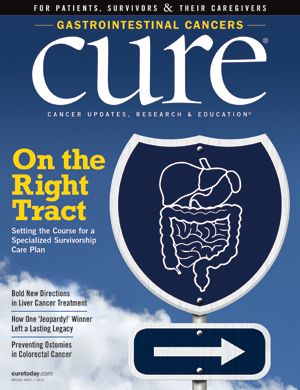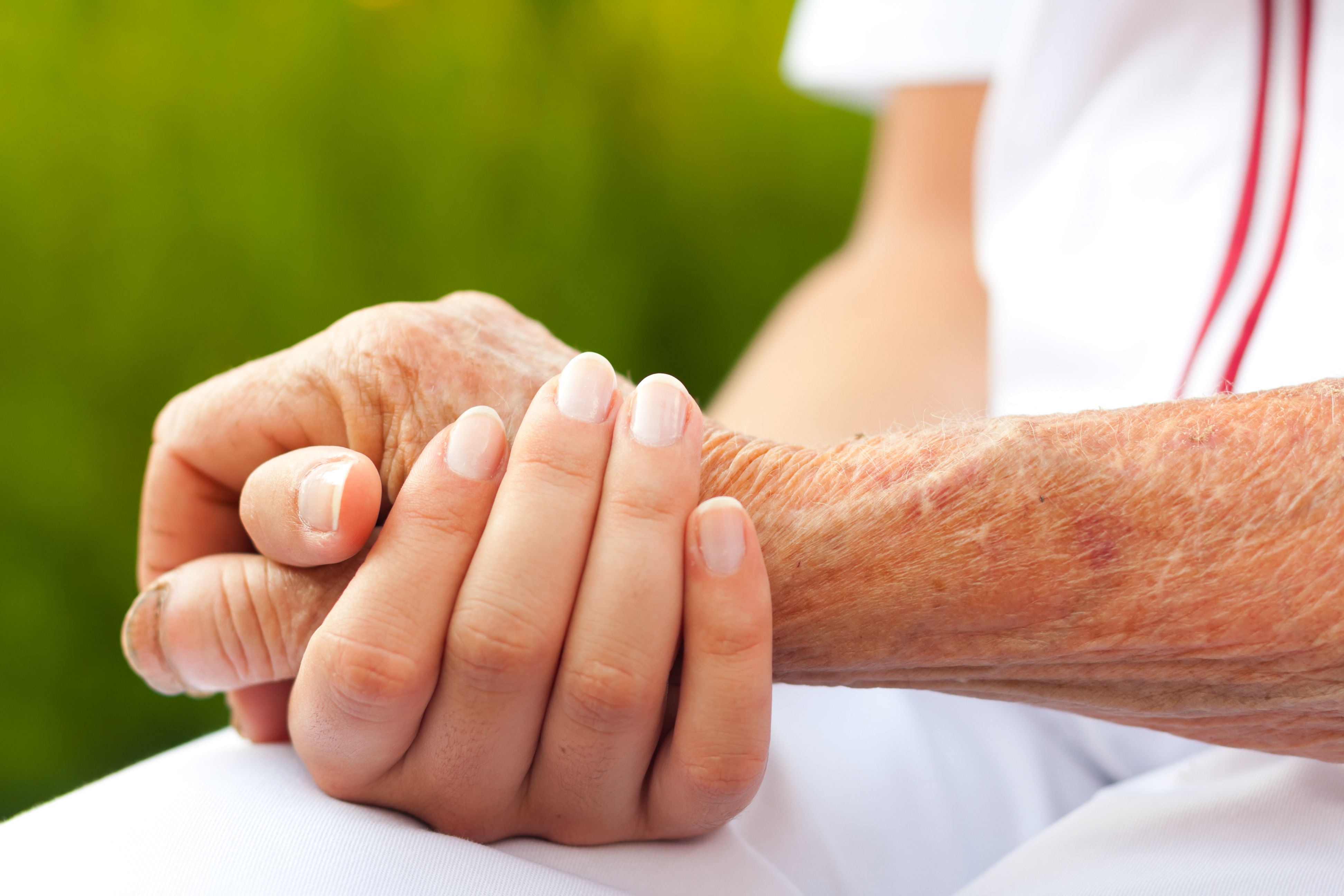Publication
Article
Turning Pain Into Purpose With GI Cancer
Author(s):
A survey about life after GI cancer has sparked the creation of specialized survivorship care plan.
When Martha Raymond, M.A., CPN, executive director of Michael’s Mission and co-chair of the GI Cancers Alliance, conducted an anonymous online survey to explore the unmet needs of patients with gastrointestinal (GI) cancers, she was shocked at their gutwrenchingly honest and disheartening responses.
“Fifty-one percent didn’t even know what a survivorship care plan was,” Raymond says of the 507 participants in the six-week national survey conducted in the fall of 2016. “Another 23 percent said their health care provider never mentioned the need for one.” Based on Raymond’s data, only 8 percent of those who survive GI cancer have a survivorship care plan in place.
Yet in 2005, the Institute of Medicine recommended that each cancer patient, upon completing treatment, be equipped with such a roadmap; now, centers that want accreditation from the Commission on Cancer are required to provide survivorship plans, including treatment summaries and follow-up/surveillance recommendations.
The survey — which included surviors of colon, stomach, rectum and other cancers, most of whom had been diagnosed at stage 3 or 4 — found that such plans could be helpful to this population, as most said their struggle didn't end once treatment did.
That struggle comes in many different forms: Over 50 percent of respondents reported feeling anxiety, depression, fear and sadness during treatment or survivorship, with 20 to 40 percent reporting hopelessness, denial and anger; in addition, many didn’t understand the steps they needed to take to help safeguard against cancer's return. Because GI cancer consists of 10 different diseases with varying stages and side effects, no two patients will ever have the same follow-up plan. And because there is no single set of guidelines across oncology on how to follow GI survivors, most patients feel uneducated and uncomfortable when it comes to their own survival.
BATTLING THE UNKNOWN
One of those survivors is Scott Murchie, who was diagnosed with stage 3 rectal cancer in April of 2011, when he was 48. After a fecal occult blood test, colonoscopy and upper endoscopy ordered due to a family history of polyps, Murchie’s GI doctor found a lime-sized tumor, immediately launching the resident of northern Virginia into a full-scale treatment plan.
“There were no signs or symptoms,” Murchie says. “I got the luckiest break in the world … If he didn’t order that test, who knows what would have happened?”
After four and a half months, during which he underwent two separate chemotherapy regimens, six weeks of daily radiation and two surgeries, Murchie then had to face an equally hard, yet lesser-known battle: survivorship. “You’re so focused on the treatment every step of the way, just getting through it,” Murchie says. “Then you’re done, and you don’t want to feel ungrateful, but this is in some ways when all the hard work happens. You ask yourself: What’s supposed to happen to me now? What am I supposed to do? How do I deal with the aftereffects both psychologically and physically?”
Although colorectal cancer is the third leading cause of cancer-related deaths in both men and women in the U.S., that death rate has been dropping steadily over the last few decades due to advanced screening and improved treatment options. However, even though there are more than a million survivors of GI cancers, many health care professionals are battling the unknown when it comes to follow-up care and helping patients to navigate the longterm side effects of treatment.
“This poses many challenges,” says Lei Zheng, M.D., Ph.D., associate professor of oncology at Johns Hopkins Sidney Kimmel Comprehensive Cancer Center. “These patients survive cancer, but they’re left dealing with consequences, even though [treatment] is what led to their cure.”
For example, surgery is the main treatment option for the 80 percent of colorectal cancers that are nonmetastatic, or have not spread from the primary site. While this is potentially curative, more than 40 percent of patients in stage 2 or 3 will have a disease recurrence, making follow-up care critical to catch the recurrence before it spreads, while it may be curable with surgery. This care is also important in helping survivors to deal with chronic functional gastrointestinal issues, such as the management of colostomy bags. Zheng notes that the side effects of radiation, chemotherapy and even CT scans (which employ radiation) are also a cause of concern, because the long-term effects of many treatment options are still unknown. In some cases, it is possible that treatments for an initial GI cancer can contribute to the development of a secondary cancer.
“Those things that you were so grateful to receive to cure you also cause you concern moving forward,” Murchie says. “Just going away and knowing that my appointments were done didn’t feel safe to me. Because even if you’re cured, there’s always the question of: ‘What happens now?’”
Finally, other forms of GI cancer that are less treatable than colorectal cancer pose a different set of problems — for example, while survival rates have been improving decade to decade, pancreatic cancer, detected most commonly at an advanced stage, is still considered largely lacking in significantly effective treatment options, with a one-year survival rate of 20 percent and a five-year survival rate of only 7 percent.
“Not many patients actually survive pancreatic cancer, and very few patients are cured,” Zheng says. “Therefore, the follow- up of these patients forms a different challenge, because of the stress caused by the high recurrence rate of this deadly illness and by the uncertainty of the recurrence time.”
TURNING PAIN INTO PURPOSE
Raymond discovered her passion for helping GI cancer patients and survivors after both her parents were diagnosed with colon cancer during her intermediate school and college years.
“There was no information, obviously no Internet back then,” Raymond says. “It was very isolating, to say the least.”
Now, finding strength in her motto to “turn your pain into your purpose,” Raymond is partnering with the GI Cancers Alliance to develop the first survivorship care plan that will be tailored to the specific needs of patients with GI cancers. The plan will be customizable for each disease state and address specific needs of patients with GI cancers and their caregivers.
A draft version of the plan will be available in June at the annual meeting of the American Society of Clinical Oncology (ASCO), where members of the GI Cancers Alliance will review the document and offer comments, edits and suggestions. Those interested in using the plan can look for it on the GI Cancers Alliance website at GICancersAlliance.org, where it will be posted when ready.
“It will encompass things like helping patients know when they need to go back for blood work, scans, colonoscopies or endoscopies,” Raymond says.
“But it’ll also cover things such as the emotional and psychosocial aspects of survivorship … because the quality of life concerns are just as important as the physical concerns.”
In the meantime, although it does not broadly apply to patients who have survived any variety of GI cancer, ASCO offers a survivorship care plan template that is specific to those who have had colorectal cancer (https:// tinyurl.com/hhzjk9b).
There are also online guides, such as one from Livestrong (https://tinyurl.com/j6rrllm), that can help people who have had cancer, with the help of their doctors, to create their own survivorship care plans.
In general, Zheng and Raymond advise survivors to take a few simple steps to keep up with their own follow-up care. “Always consult with your health care professionals and really ask questions,” Raymond says. “Get as much education on your disease as you can from trusted sources like the National Cancer Institute, and find out what all your options are. The more information you have up front, the better prepared you are.”
Zheng stresses that followup care looks different for every patient, but suggests that many survivors undergo surveillance CT scans, colonoscopies or endoscopies and participate in clinical follow- ups to analyze their family history. For example, if it is found that the patient has Lynch Syndrome, a genetic condition associated with a higher risk of GI cancer, the patient will likely need a more rigid and comprehensive follow-up plan.
In order to manage the emotional and psychosocial consequences of GI cancer, Raymond suggests that all survivors should focus on regaining control where they can, and seek out support among a variety of sources.
“When someone is diagnosed with cancer in general, that feeling of control is gone,” she says. “But doing something as easy and as simple as putting together a binder of your health care information, blood work, scan results and appointment follow-ups … it gives the patient that feeling of control again. They start to feel like, ‘OK, I got this.’”
From the patient perspective, Murchie agrees. “I made sure the information shared between all of my providers continued to flow together after treatment,” he says. “Every single provider I went to, I wanted to make sure that the information got hooked up together to try to figure out if anything was particularly meaningful, or if it was just information they could use to put together a picture of treating me long-term.”
BEING YOUR OWN ADVOCATE
Due to the wide array of symptoms, side effects and health concerns that accompany GI cancers, Raymond, Zheng and Murchie all agree: Being your own best advocate is the most effective form of follow-up care.
“A lot of folks will have opinions on what you should do, so be true to yourself about what feels comfortable,” Murchie says. “Gather information so you feel comfortable with the game plan moving forward. If it doesn’t sound right, feel right, or you’re not getting scheduled for follow-ups, you really have to advocate for yourself.”
“Be the co-captain of your own health care,” Raymond echoes. “Seek support, get education and really let your oncologist know that you want to have a say at the table.”





